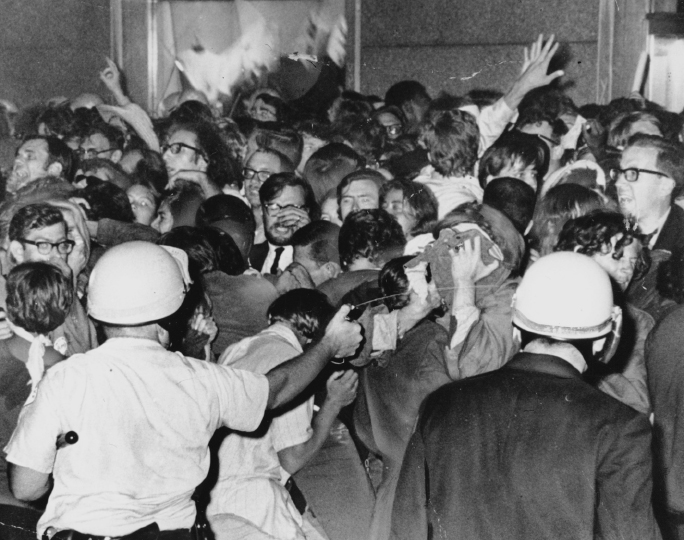The Tumultuous Election of 1968
Printed Page 883
Disorder and violence also entered the election process. In June, two months after the murder of Martin Luther King Jr. and the riots that followed, Senator Robert F. Kennedy, an antiwar candidate campaigning for the Democratic Party’s presidential nomination, was killed by a Palestinian Arab refugee because of his support for Israel.
In August, protesters battled the police in Chicago, site of the Democratic National Convention. Several thousand demonstrators came to the city, some to support peace candidate Senator Eugene McCarthy, others to cause disruption. On August 25, when demonstrators jeered at orders to disperse, police attacked them with tear gas and clubs. Street battles continued for three days, culminating in a police riot on the night of August 28. Taunted by the crowd, the police sprayed Mace and clubbed not only those who had come to provoke violence but also reporters, peaceful demonstrators, and convention delegates.

The bloodshed in Chicago had little effect on the convention’s outcome. Vice President Hubert H. Humphrey trounced McCarthy by nearly three to one for the Democratic nomination.
In contrast to the turmoil in Chicago, the Republican convention met peacefully and nominated former vice president Richard Nixon. In a bid for southern support, Nixon chose Maryland governor Spiro T. Agnew for his running mate. A strong third candidate entered the race when the American Independent Party nominated staunch segregationist George C. Wallace. The former Alabama governor appealed to Americans’ dissatisfaction with the reforms and rebellions of the 1960s and their outrage at the assaults on traditional values. Nixon guardedly played on resentments that fueled the Wallace campaign, calling for “law and order” and attacking liberal Supreme Court decisions, busing for school desegregation, and protesters.
CHAPTER LOCATOR
How did U.S. foreign policy change under Kennedy?
Why did Johnson escalate American involvement in Vietnam?
How did the war in Vietnam polarize the nation?
How did U.S. foreign policy change under Nixon?
Conclusion: Was Vietnam an unwinnable war?
 LearningCurve
LearningCurve
Check what you know.
Nixon and Humphrey differed little on the central issue of Vietnam. Nixon promised “an honorable end” to the war but did not indicate how to achieve it. Humphrey had reservations about U.S. policy in Vietnam, yet as vice president he was tied to Johnson’s policies. With nearly 13 percent of the total popular vote, Wallace produced the strongest third-party finish since 1924. Nixon edged out Humphrey by just half a million popular votes but won 301 electoral college votes to Humphrey’s 191 and Wallace’s 46. The Democrats maintained control of Congress.
The 1968 election revealed deep cracks in the coalition that had maintained Democratic dominance in Washington for the previous thirty years. Johnson’s liberal policies on race shattered a century of Democratic Party rule in the South, which delivered all its electoral votes to Wallace and Nixon. Elsewhere, large numbers of blue-collar workers broke with labor’s traditional alliance with the Democrats to vote for Wallace or Nixon, as did other groups that associated the Democrats with racial turmoil, poverty programs, changing sexual mores, and failure to turn the tide in Vietnam. These resentments would soon be mobilized into a resurging right in American politics (as discussed in chapter 30).
QUICK REVIEW
Question
How did the Vietnam War shape the election of 1968?